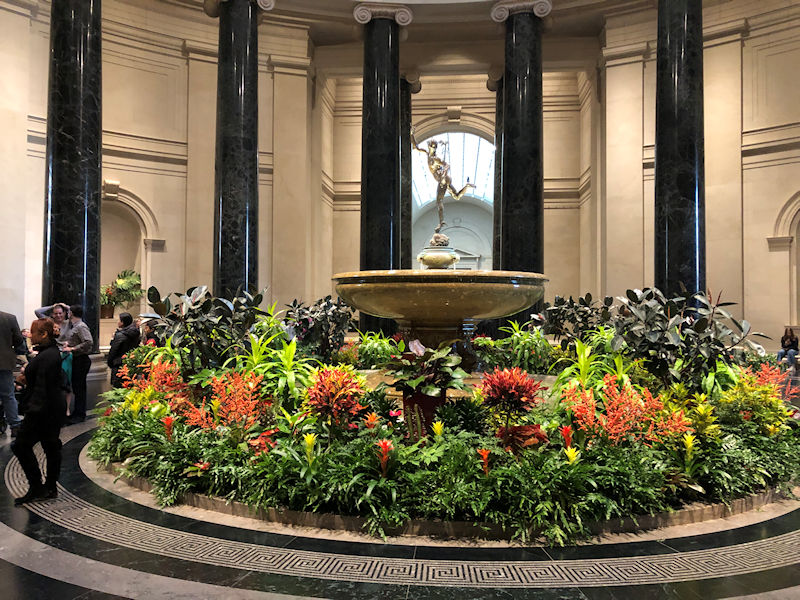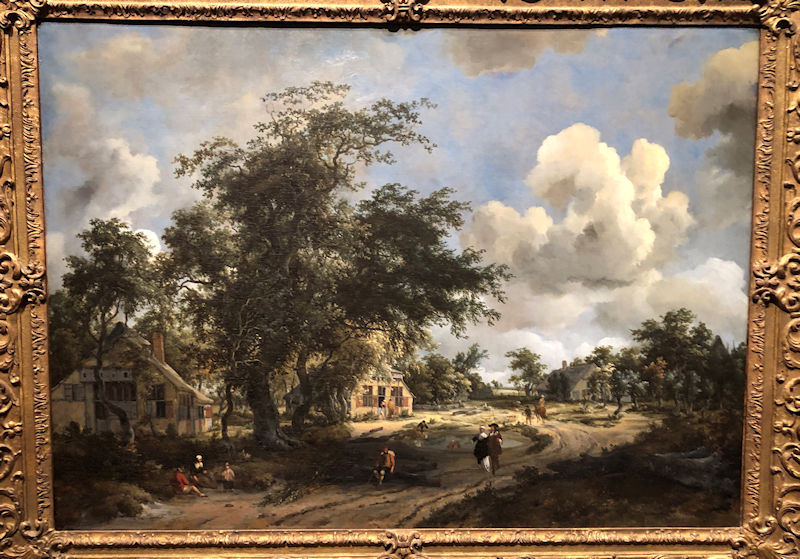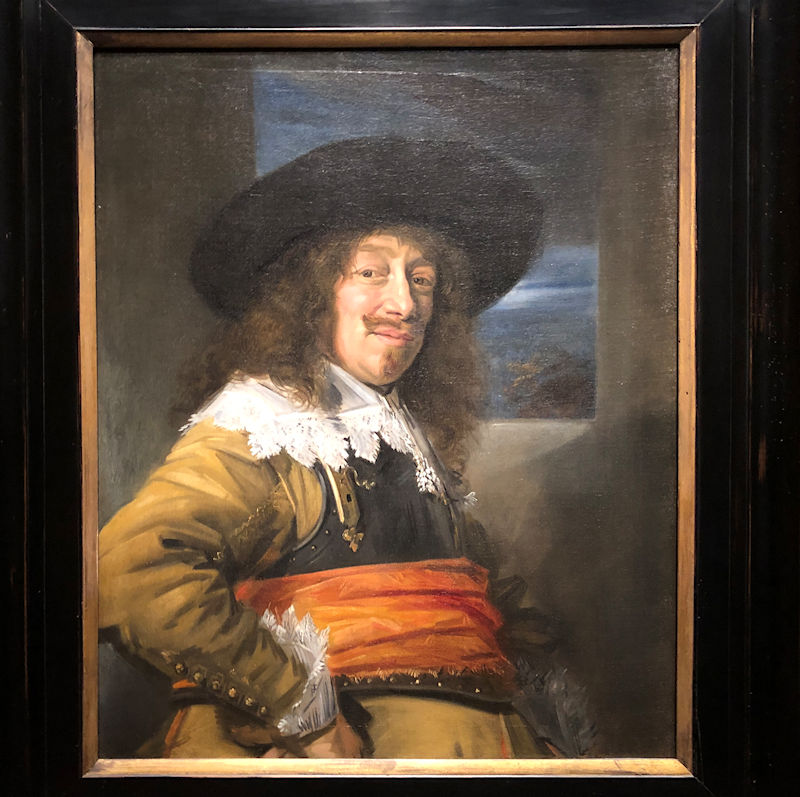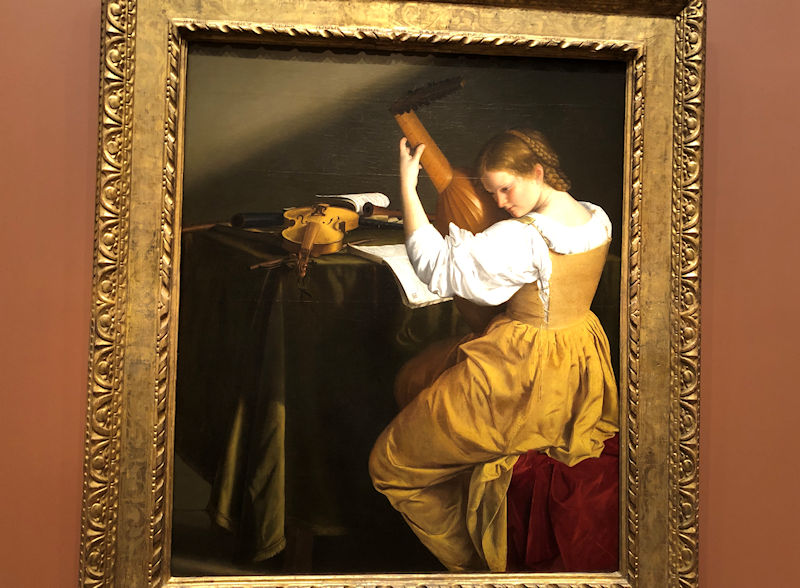You may not find this terribly rewarding unless you're included here, so this is a good time for casual and random browsers to turn back before they get too caught up in the sweep and majesty of the proceedings and can't let go.
The National Gallery of Art in D.C.
after an all-you-can-eat brunch in Georgetown, 25 November 2023

Eagerly anticipating whatever, we're lining up for the metro . . .

. . . a block from our Hilton Garden Inn in Alexandria.

A serviceable vehicle arrives right on time, and we're off.
That's the George Washington Masonic National Memorial looming beyond.

The gang's all here, Alison and Kristin, and Tim and Whitney just ahead, and Kristin is expressing astonishment . . .

. . . at a gaggle of hydrobikes, our very own hydrobikes from Minneapolis now evidently available for rental all over the country. These, of course, look newer, shinier, a bit less battered up than ours in northern Wisconsin, which are nearly 30 years old.

That Tall Whatever, prominently facing the Washington Harbor in Georgetown, is for better or worse called 'Scarlet by Arnie Quinn'.

Tim and Kristin, anticipating the all-you-can-eat brunch, are outpacing us.

We're bound for one of our hosts' favorite bruncheries, by the Washington Harbor Ice Rink.

There it is, an amazing place, stretched along the ground floor (and patio in warmer weather) directly across the rink -- it's called Farmers Fishers Bakers and it really does put on an elaborate and plentiful buffet-style brunch menu on weekends, an inspired way to get a start on the mid-day.

Tim, Whitney, and Ali

Stuffed and bloated afterward, we're discussing plans. Our hosts have previous reservations for the Celtic Woman Christmas performance, and we're getting our instructions for getting to the National Gallery of Art without them.

A fine day out, and next . . .

. . . a stop-in at the Kennedy Center for the Performing Arts, especially for those of us who've never been there (i.e., me).
That view has been cropped off and blown up from the photo just above.

The exhibitions are amazing . . .

. . . devoted to the incredible number of diplomatic, cultural/artistic, and domestic and foreign policy causes, achievements, and inspirational interventions Kennedy made in less than three years. Presenting them all together here makes for a sobering contrast with nearly all of the previous presidents and certainly all of the subsequent ones.

And there's a nice terrace on the roof as well.

-- Pleased to be here.

Now we just have to find the National Gallery of Art. That's not it.

There it is. No, wait, it's not. That's Natural History.

That's not it either!

And it can't be that embarrassing bullfight arena up ahead . . . it's presently just a waste of space.

We found the Gallery in the end -- after all, we were just a year ago [got lost then, too]. That time, we spent most of our time in an exhibition of the works of Vittore Carpaccio, 'master storyteller of Renaissance Venice', which was fabulous, followed mostly by a wandering round amongst other Renaissance and Baroque era Italians.

No ticket takers by the entrance -- it's all free. What a wonderful government. For the moment, anyway.

So this time we'd like to focus on the Netherlandish artists and maybe a few Germans as well.
We're including here only the ones we liked best and which came out as usable photos (with an iPhone8).

First some Dutch artists, Rembrandt, of course, like this one of Lucrezia, done in 1664, late in his life.

And this one of 'Ascagnes and Lucelle (The Music Lesson)', by Jan Steen in 1667. The Gallery's notes explain that this is a scene from a recent tragicomedy in which upper-class Lucelle is being seduced by the servant Ascagnes and will be squealed on by another servant who's peeking in the door. Her father tries to poison them but it all ends happily in the end. So it's not really just a Music Lesson at all.

By Vermeer, Woman Holding a Balance, dated to about 1664 ('Almost all his paintings are apparently set in two smallish rooms in his house in Delft; they show the same furniture and decorations in various arrangements and they often portray the same people, mostly women' (Wikipedia).)

A Nurse and a Child in an Elegant Foyer, in which the little girl is making a donation to the poor family, by Jacob Ochtervelt, 1663

Another cute little girl, The Bedroom, by Pieter de Hooch, 1658-1660

Dirck Hals, Merry Company on a Terrace, 1625

Skating on the Frozen Amstel River, by Adam van Breen, 1611

Then a few Flemish: this by Jan Brueghel the Elder, Wooded Landscape with Travelers, 1610

Tavern Scene [no kiddiing!], David Teniers the Younger, 1658

Peasants Celebrating Twelfth Night, also David Teniers the Younger, 1635

Another by the Dutch: Isack van Ostade, The Halt at the Inn, ca. 1645 [when he would have been only 24]

Also Dutch: Meindert Hobbema, A View on a High Road, 1665

This well-known classic is A Member of the Haarlem Civic Guard, by Frans Hals, ca. 1636/1638.

And equally well-known, this insufferable twit, Willem Coymans, by Frans Hals, 1645

The Dancing Couple, an exuberant picture also by Jan Steen, 1663

The Fall of Man, 1616, by Hendrik Goltzius, late in his life -- a picture perhaps most memorable because of . . .

. . . the resentful First Cat in Eden.

A strangely crowded picture, The Meeting of Abraham and Melchizedek, by the Flemish Rubens, ca. 1626

An earlier picture by Rubens, Daniel in the Lions' Den, dated to ca. 1614/1616, i.e., when he was back in Antwerp for a while

Gerrit van Honthorst's The Concert, 1623. Van Honthorst (1592-1656) of Utrecht visited Rome in 1616, imbibed the current styles, went home in 1620, and was part of a group known as the 'Utrecht Caravaggisti'. He also visited England briefly in 1628 and painted portraits of King Charles I and Henrietta Maria.

This is a characteristic portrait by Sir Anthony van Dyck, one of many English nobility who sat for him. This is Catherine Howard, Lady d'Aubigny, dated to
ca. 1638, about the time that this daughter of the 2nd Earl of Suffolk secretly married George Stuart, 9th Seigneur d'Aubigny, against King Charles' and her parents' wishes. She was an ardent Royalist and worked as a spy when visiting London, serving time in the Tower of London until the French ambassador intervened on her behalf. After Aubigny, a Royalist commander, was killed four years later at Edgehill, she married again in 1648 and the pair planned to engineer the freedom for the king on his way to his trial; it failed, obviously, and they had to flee to the Netherlands, where she died in 1650.

This is labeled as a portrait of Deborah Kip, wife of Sir Balthasar Gerbier, and Her Children, 1629/1630, by Rubens ('and possibly Jacob Jordaens'). Gerbier was an Anglo-Dutch diplomat, courtier, author, and all-round artist. He moved to England in 1616; Rubens lodged with him in London during a visit in 1629, and he was appointed Charles I's resident agent in Brussels 1631-1641.

This is the 2nd Earl of Essex, the tragically arrogant Robert Devereux, by 'Studio of Marcus Gheeraerts the Younger', dated 1596/1601 -- unlikely to have been much after that, since Essex was executed by Queen Elizabeth in February 1601. Gheeraerts and his artist father had fled to London when he was very young, in the 1560s, as refugees from the Spanish tyranny in the Netherlands, and he is said to have effected 'a revolution' in Tudor court portraiture in the 1590s with his lifelike impressions and 3D effects. Essex employed him from 1596.

Rubens spent 1600 to 1609 studying in Italy and visited Genoa twice; in 1606, he painted this portrait of the Marchesa Brigida Spinola Doria -- according to the notes, though, it may have originally been a full length picture that was cut down in the 19th century. The 22 year old lady was a member of the very high level Spinola Genovese family who'd just married her cousin from the even higher level Doria Genovese family; she was widowed in 1613 and remarried into another high level family, the Imperiales, and van Dyck's portrait of that chap is here in the Gallery, too, though we didn't notice it.

Stepping back a few centuries, this is a Saint Anne Altarpiece, ca. 1500/1520, from Gerard David and Workshop. St Anne is holding the Virgin Mary and Christ Child, flanked by St Nicholas and St Anthony of Padua with another baby, presumably John the Baptist. The chronologies seem somewhat out of whack.

The 'Netherlandish' Maerten van Heemskerck's Rest on the Flight into Egypt, ca. 1530

Leaving the Low Countries briefly, this is an old favorite, A Lady in Her Bath, ca. 1571, by the Frenchman François Clouet. Along with a lot of other people eager to be in the picture.

But this is another old favorite, The Ill-Matched Lovers, by the usually satirical Quentin Massys of Antwerp, ca. 1520-1525.

The Marketplace in Bergen op Zoom, ca. 1590/1597, 'attributed to Abel Grimmer'

Another Netherlandish Madonna and Child, ca. 1532, by Jan Gossaert
(-- You want the apple? Come and get it!)

This crowded but fascinating picture, presumably an altarpiece, is labeled 'Mary, Queen of Heaven', by the 'Master of the Saint Lucy Legend', an unidentified painter active 1480-1510 in Bruges, then in the County of Flanders, now in Belgium. Some 25 to 35 paintings are said to have been attributed to him by now, and most have views of Bruges in the background. He's been associated with the work of Dieric Bouts and Hans Memling. [Why do all the angels' faces look the same as Mary's?]

Speaking of Hans Memling, this is his well-known ca. 1470 picture of St Veronica with the non-canonical 'veil' or 'napkin' with which, by the 14th century, she was understood to have wiped Christ's face at the Sixth Station of the Cross, miraculously printing his face on it. (She may or may not have traveled to Rome to present the veil to Emperor Tiberius.)

The very good 'Madonna of Humility', by Jacopo della Quercia of Siena, dated to about 1400. We've encountered his splendid work before in Siena and Lucca, and he's said to have been influenced by his contemporaries Donatello, Brunelleschi, and Ghiberti.

This is an odd combination of a neonatal Christ Child and a bearded adult John the Baptist, centered on Saint Anne and including a possibly pre-teen Madonna Mary, dated to ca. 1511. It's by Hans Baldung, ca. 1484-1545 (with or without his nickname Grien tacked on), who's not well known to us, a German from the southwestern Swabia region who was most associated with Strasbourg and 'considered the most gifted student of Albrecht Dürer' (Wikipedia).
In addition to traditional religious subjects, he was also prolific in themes of witchcraft and sorcery, we're told -- the only works of his we've seen before are two versions of a grisly 'Death and the Maiden' (one & two) in the Basel Kunstmuseum.

Here is an amazing tableau on colored wood, 'The Holy Kinship', dated to ca. 1480/1490, and attributed merely to 'South German (Swabian or Franconian)'.

The Crucifixion with the Converted Centurion, 1536, by Lucas Cranach the Elder; the 'centurion', dressed as a 16th century German cavalryman, is saying in German 'Truly, this man was the Son of God', quoted from the Gospel of Mark.

Cranach's Madonna and Child, 'ca. 1535 or after'

But Cranach did not only occupy himself with pious Protestant religious themes -- this is The Nymph of the Spring, dated 'after 1537'.

Portrait of a Clergyman, by Dürer, 1516
(apparently not a Protestant, since he's anticipated Luther's 95 Theses by a year).

We can never pass up a picture of Saint Lucy with her eyes on a plate, this one by Francisco de Zurbarán, ca. 1625/1630 -- all dressed up as an aristocratic lady of 16th century Seville rather than a 4th century Syracusan martyr.

We don't find this Martyrdom of Saint Gennaro (ca. 1685) very appealing, despite what looks like a strong Caravaggio influence -- but as Mattia Preti was born in Calabria in the Kingdom of Naples, and worked in Naples for a long period, and as we've just come from Naples and its Duomo (though we didn't get to see the saint's blood miraculously liquify, maybe next time), we wish to pay a little homage. [Gennaro = St Januarius]

The Rebuke of Adam and Eve, by Domenichino, 1626, with a snake that's trying to scurry out of the line of fire, an Eve trying to blame the snake, an Adam who doesn't know what the big fuss is about and it wasn't his fault anyway, a lamb who's disapproving, a God the Father who's brought along his entourage in support, and a lion that looks like an afterthought. In the 1620s Domenichino was working in Rome, but -- speaking of St Gennaro -- from 1631 to his death in 1641, he was devoting himself to 'the most prestigious, and very lucrative, commission in Naples, the decoration of the Cappella del Tesoro di San Gennaro of the Naples Cathedral. His Scenes from the Life of San Gennaro occupied him for the rest of his life' (Wikipedia).

This picture is a twofer: it's by Lavinia Fontana, a brilliant painter in Bologna (1552-1614), and depicts another successful female artist in Bologna, Lucia Bonasoni Garzoni, in ca. 1590, a well-known lutenist and singer who, from the inscription at the top right was about 28 years old. She was also the godmother of Lavinia Fontana's 11th child. It was in about 1590 that Fontana accepted a commission from the pope and moved with her family to Rome, where she died in 1614.

Saint Cecilia and an Angel, by Orazio Gentileschi (Artemisia's dad) and Giovanni Lanfranco, ca. 1617/1618 and ca. 1621/1627.

The Lute Player, also by Orazio Gentileschi, ca. 1620. This has been called his masterpiece, but until 1922 (when a bill of sale was located*) it was assumed to have been by Caravaggio, who made his own undisputed lute player picture which may have influenced this one.
(* from De Grazia and Garberson, Italian paintings of the 17th and 18th centuries (National Gallery, 1996), p. 97)

Soldiers Playing Cards and Dice (aka The Cheats), by Valentin de Boulogne, ca. 1618/1620

Simon Vouet's Saint Jerome and the Angel, ca. 1622/1625. Vouet lived and studied in Rome from 1614 to 1627, where he was a friend of Artemisia Gentileschi and painted her portrait in 1623. The lighting is suitably Caravaggesque but the overdressed, curly-haired little angel with the thick cardboard wings is a bit clunky.
Simon Vouet and Virginia da Vezzo married in 1626, and she's considered to have painted her own version of Judith with the Head of Holofernes, ca. 1625, which isn't as forceful as Artemisia's -- in any case, in some places it's catalogued as by Simon Vouet with his wife as the model.


The rather goofy Feast of the Gods, by 'Giovanni Bellini and Titian', 1514/1529. In Ovid's joke in the Fasti, Priapus (on the right) tries to lift up the gown of a sleeping nymph and the donkey makes a racket and all the gods have a laugh. It was commissioned by Duke Alfonso d'Este for his palace in Ferrara and Bellini completed it in 1514, but later His Grace had Dosso Dossi come in and make alterations, and then Titian came along and painted out most of Dossi's work and put in the mountainous background. Only the partying gods are Bellini's.

This is a bust of Don Pedro Alvarez de Toledo, attributed to 'Florentine or Neapolitan 16th century, probably 1560/1600'. Assuming that this is THE 'Don Pedro Alvarez de Toledo', he was the effective but tyrannical Spanish Viceroy of Naples (1484-1553, viceroy 1532-1553), urban planner, 2nd cousin of Emperor Charles V, and father-in-law of Cosimo I de' Medici, Grand Duke of Tuscany. He was an extremely harsh ruler, but 'Don Pedro's reputation as a city-builder has stood the test of time'.
The main north-south pedestrian commercial street in Naples is the Via Toledo, adjacent to the city's Spanish Quarter, which he'd created to house the Spanish garrison and their horses. We've just come back from there, as it happens.

It's Bacchus again, a perennial favorite, with his bunch of grapes and little boy (though this little boy has hooves and horns on and is a faun, the Italian equivalent of a Greek satyr).

Trudging back to the Metro in late afternoon, with the monument showing the way

A long day, who wants to go out for dinner? We had the hotel's bar and short-order kitchen to ourselves. Furnished with an entertaining bartender, too.
Next up: The Dyke Marsh Wildlife Preserve and a look round Historic Occoquan

 Dwight Peck's personal website
Dwight Peck's personal website











































































